We all love seeing (and pawing through, when given the opportunity!) the fantastic collections built up by gun collectors who have had the twin resources of time and money on their side, but few of us can afford to invest in that sort of undertaking.
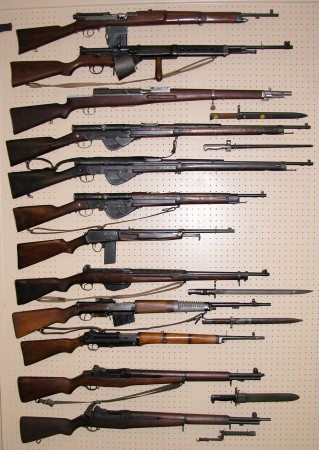
Fortunately, there are still a bunch of opportunities for the collector on a budget. It’s all about supply and demand, so what we need to find are collecting niches where the supply (or perceived supply) is high and the general interest is low. Many years ago when my father started collecting guns, Japanese rifles were a great example of this niche. He was able to assemble a pretty comprehensive collection or Arisakas and other Japanese arms without paying an arm and a leg because most folks just didn’t care much about them. Those days have largely passed, though, as you’ll find out if you look for a Type 2 paratrooper or a Type 97 sniper.
Just a few years ago, Mosin Nagants were another great example of this. Boatloads of Mosins came into the country, flooding the market and driving prices way down. Most of these imports are post-war refurbished 91/30 models, but lots of other models got swept up in the common perception of “cheap Mosins”, like the M38 and M44 carbines, PU snipers, Finn-capture M91s, and so on. That situation is still holding on to some extent, but its days are clearly numbered. Unless another big batch gets imported, the era of the $79 Mosin is history.
So what is the opportunity today for a collection funded by a loose change jar? Well, I think Turkey is a great one. Turkish rifles meet both of the basic criteria – a whole bunch came into the US, and not many people are interested in them. Most folks think of Turkish rifles as junk, when they are in fact very well-made guns. Many (most?) of the ones imported saw a long a rough service life, and are left in various states of wear that don’t do much to improve their general perception.
Turkey (well, the Ottoman Empire) was on the losing side in World War I, and not many of its combat exploits are well known today (in popular culture, Gallipoli
seems to have been the Australians against some faceless and anonymous foe). They stayed out of World War II completely, leaving them without that element of military history to become well known. So for most people, Turkey is just a blank spot on the map that apparently produced nothing but beat-up Mausers covered in cosmoline.
However, for the person with a deeper interest and understanding, I think Turkey is a fascinating country, straddling the Eastern and Western worlds, and the influences of Islam and Christianity. They also maintained a pretty large military, stayed on top of the state-of-the-art in small arms technology, and had a proclivity for upgrading and updating weapons rather than sell them off. What this means for us today is a fantastic number of models and variations to search out.
Turkey purchased new Mauser rifles of several designs, including the early 71/84 model, 1893 Spanish-model ones with magazine cutoffs, 1903 Gewehr 98 models, and more. They initially used the 7.65mm Mauser cartridge, but changed to 7.9mm (8mm Mauser) in 1927 and retrofitted most of their rifles to this caliber (so for the advanced Turkish collector, 7.65mm guns are a treat to seek out). They also bought Gewehr 88 “Commission” rifles and Gewehr 98 Mausers from Germany and vz.98/22 MAusers from Czechoslovakia, and in 1939 started producing their own Mauser-style rifles and short rifles at the new Kirikkale rifle factory. Between 1927 and 1929, Turkey switched from the 7.65mm to the 7.9mm cartridge, began refurbishing all of their older rifles, and changed from Arabic-style script to Roman characters – which makes pre-change surviving examples another interesting set of guns to look for.
For the basic starting collection, one can pretty easily find a Gewhr 88/05 and 88/05/35, an 1893/38, K.Kale-produced M1938, and M38/46 short rifle each for under $200. Next up are a Gewehr 98 from Germany, a Czech 98/22, and a M1948 “Orman” Berthier conversion. Another rare but very neat Turkish converted rifle is the “Enfauser” (not its official name, clearly) – an Enfield captured at Gallipoli and converted to 8mm Mauser with a 5-round internal box magazine. For the more advanced collector, older rifles like Martini-Henrys and lever-action Winchesters were also used in large quantities by Ottoman armies.
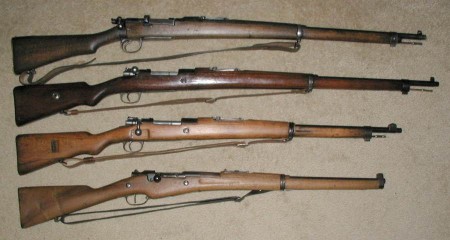
Want to get into this under-appreciated collecting corner? Here are a couple resources to start you off:
TurkMauser.com‘s listing of Turkish Rifle Models

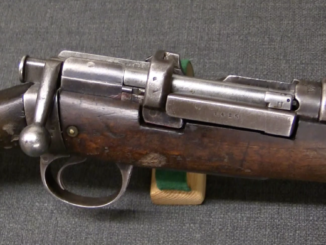
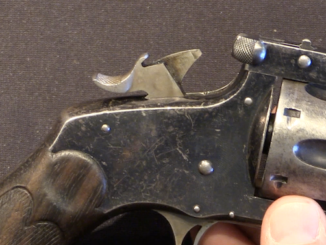
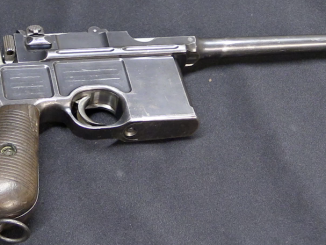
Well FG team you pretty much pushed the public to get hold of Ottoman arms I guess, I would if I only could to and more over Ottoman Empire is one of my favorite ones :-).
If anything, they were the most comfortable army/empire. You know what I mean…HA HA. They did have good taste in military hardware,though, much as I hate to admit it.
I am a Turk and do not understand why you think so. In Korean War Turks sacrificed
nearly 800 honorable soldiers in a few days to save your American ass.
It was supposed to be a pun. I am sorry if I offended you. My ass is Greek by the way (born in the US, but fully Greek).
Strongarm – An “ottoman” is also a piece of padded furniture. It got the name because the original ones were imported from Turkey a few hundred years ago.
Never mind. Glad to meet you Big Al, MG.
Likewise. Sorry for the misunderstanding.
I traded a Cimarron “Thunderer in ’45 LC and an expensive leather rig for $25 and a Turk Mauser when I was destitute after my stroke in 2002 and needed to get the pistol & rig out of pawn before I lost it (it was actually the pawn ticket I traded) – bad trade, but what the Hey it went to a bud and not to some schmo…turns out the receiver date is 1954…didn’t think ANYONE was still manufacturing bolt action rifles at THAT late date,,,good condition – not my absolute favorite, but a collectible Mauser nonetheless.
CB in FL
Is it also marked with a somewhat stylized “ATF” on the receiver? That would make it one of the last batches of rifles (mostly German G98s) that were overhauled and updated at the Ankara Rifle Factory in the mid 50s. Neat!
The turks brougt WINCHESTERS IN ¤¤ henry Flat and S&W in the same caliber. But the turks know the prises of those. A friend of mine found one of the S&W in an antike shoop in istanbul
The Ottoman Empire did utilize technologically advanced firearms during the Russo-Turkish War of 1877, and especially in the Siege of Plevna (in modern-day Bulgaria now) in which the defending Turks utilized repeating Winchester 1866 lever-action rifles were able to significantly delay the Russian advance down the Danube River delta towards their eventual objective of Constantinople. While the new weapons weren’t really a war-winning advantage the Turks had, it did demonstrate the utility of rapid firepower over single-shot marksmanship.
http://www.militaryrifles.com/turkey/Plevna/ThePlevnaDelay.html
“it did demonstrate the utility of rapid firepower over single-shot marksmanship”
Not really, it just proved that if you want to win a war against the numerically superior enemy, you have to have BOTH rapid firepower AND single-shot marksmanship. It wasn’t that the Turks had ONLY the Yellow Boys. Actually they had as many (or as little) as 500 Winchester 66s of Musket variation (with the longest 27-in bbl, bayonet and magazine holding as many as 17 rounds .44 Henry RF) for the entire force of 40K defenders. They also had, and used with as deadly an accuracy, the Snider and Peabody Martini rifles – and there were as many as 25K of the latter in Plevna fortress. The Peabodies were used for stand-off work firing at advancing columns at distances of up to and including 2000 yds (together with very effective quick-firing Krupp artillery), and then Winchesters replaced them on the ramparts when the Russians closed enough to start assualt. Osman Nuri Pasha’s 40000 men have inflicted equal number of casualties on 150K strong Russian army at the cost of 10 000 own casualties, delaying the Russian advance until the next year.
Good points all. I could see why the Siege of Plevna reverberated the importance of marksmanship from a strategic perspective – I suppose military chiefs at the time saw the “Plevna Effect” of being able to significantly deal casualties to an enemy from afar as a means to forestall an enemy’s advance significantly to allow time and room for maneuver for other elements in area. Of course, with the benefit of hindsight, we’ve seen how firearms usage has changed from the notion of “one shot, one kill” from afar, to volume of fire today, especially in field use with the Soviets.
Here is an interesting oddity that appeared on The Firearm Blog 3 years ago: http://www.thefirearmblog.com/blog/2010/04/26/water-cooled-rifle/ It is a water-cooled Winchester rifle with a 17 round magazine, obviously intended for fortress use. I can understand how this idea came about with the combination of Turkey’s hot climate and black powder cartridges.
can I have a list of the names of the rifle in the top picture.
From top to bottom: Mondragon, Farquhar-Hill, Liu, RCS 1917, RSC 1918, RSC 1918 Carbine, Winchester self-loader, Pedersen, ZH-29, Japanese copy of the ZH-29, and two M1 Garands.
thanks
Interesting row… That Japanese copy of the ZH-29 must be the rarest of the group, maybe even more than the Liu self-loader…
Turkey has always had a proud and generally outstanding military tradition. They have proven their prowess repeatedly in many conflicts over the centuries against all manner of very formidable opponents, and have long since earned the respect of friend and foe alike the hard way.
On the subject of Turkish firearms, I see nothing wanting in them versus their better-known American and European counterparts. Turkish guns are generally well-made, effective and highly-functional, just like other quality firearms, and in some cases are actually better.
Actually even though the “middle” east stayed out of the war for the most part, country’s like what is now Turkey did exspearenced the curious beginnings of what was supposed to be the rudiments of a new German (“British” style) empire. This included raising an “SS” regiment made up entirely of Arab’s lending credence to theory that racism wasn’t truly part of the belief system of the upper echelon of German government and military, but simply a cultural myth designed to unify the people. Personally I believe that this represent an excellent example of sensationalist intellectualism as in my view the resources put toward the holocaust prove that at least some of the main power holder’s where true believers in the evil of the Jews and Slavic peoples, of course the perception that the NAZI’s hated everyone who wasn’t white skinned, blond haired and blue eyed is just blatantly ignorant but NAZI racist ideology I certainly multi layered and far from uncompromising the rewriting of many military officer family pedigrees (now called aryianization) prove that beyond a shadow of doubt.
Good introduction to Turkish military rifles. They were and are on forefront of proficient small arms use and manufacture. Central Europeans earned they lessons when dealing with Turks in past – they were well respected foes, now partners.
I do not keep detail account of their firearms industry, but on occasion, when information comes I take a note. They are a powerhouse when comes to small arms. Never heard of poor manufactured firearm from there.
ern, Denny they produced a box magazine fed shotgun with a polymer cover on the reciver that made no sense and melted but yeah they genrally do OK. I dont see the point of such a regional genralization I mean humans are phallible and they make shitty guns when they are
Polymer cover? Was it handguard? I have seen couple of slide-action and semi-auto shotguns from Turkey. In pictures they look capable. Specifically one model in bullpup format was quite innovative. I do not pose as Turk made guns advocate, just to be clear. It is just for general knowledge purposes.
Jumped on the Mauser wagon about ten years back when Century was selling Turkish rifles. Snagged some VGs at $45ea and about 20 U-Fix-Ems at $15-odd apiece. All are marked K Kale Ankara from 1938 through 194x. Oddly enough, the fixer-uppers had no import markings on them. My WAG is they were sitting in a warehouse stateside before GCA ’68. Also obtained several cases of 8mm Turk to go with them – came out to 8 cents/rd. lol I will say the rifles and the ammo complemented each other perfectly from a ballistic standpoint, as the barrel length made maximum use of the powder charge (hardly no muzzle flash), and produced 3.8MOA at 100m – might be better with someone else pulling the trigger. Ammo was doing an amazing 3100fps – about 300fps faster than commercial loadings. Another unusual thing was the powder – was 1mm squares with a celluloid base material.
Sporterized one with a bowed barrel into a .22-250 (yeah, I’m weird)and quickly discovered that the receivers are NOT a “plain ‘ol” Mauser action. Turns out that while they appear to be a regular “Large Ring”, the original barrel shank is of “Small Ring” dimensions. On top of that, there is also an extension that prevents a new barrel from being “crunched down” properly. Some extra time (and nail biting) at the lathe to remove the extension and cut a new shank on the barrel, produced a nice prairie dog gun that hasn’t even made it West of the Mississippi. Yet.
Don’t know much about Turkish surplus guns but I do own new commercial Turkish cz75 clone and a shotty and I must say that the fit an finish of the cz75 clone is the equal of any real cz ive ever owned. If they had problems in the past I think they have them resolved now.
thanks again
Is there any official designation for the “Enfauser”?
Either way I’d love to have one. Too bad they’re so hard to find.
As far as I know, the official Turkish designation is simply M938, which applies to every style of rifle they standardized on the 8×57 round in 1938 (G98s, G88s, Enfields, Czech Mausers, etc).
A little off-topic here, but the subject of vintage guns reminded me that for those of you who have rifles chambered for the 7.5mm x 55 Swiss cartridge, http://www.aimsurplus.com has a shipment of Swiss GP11 military-surplus 174-gr. ball ( FMJ ) ammunition for sale at a pretty reasonable price [ $5.49 per 10-round box, or $5.25 per box if you purchase a 60-round sleeve ( 6 boxes ) or more ]. The ammunition looks virtually brand-new in the accompanying photograph on their web site.
I have a 1938 model Turkish Mauser made in 1941. It says that it is chambered in 8mm Turkish. Is regular off the shelf 8mm Mauser safe to use in this rifle?
There is no such thing as 8mm Turkish – these rifles use normal 8×57.
Have several.
M88/05
M88/05-35
M38 (1 minty! who knew right ?)
98az (converted to at least)
Could someone list the weapons in the first photo? Really interested in the one with the fore grip
Thanks